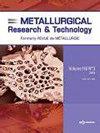Numerical study of influence of mould width on freestanding adjustable combination electromagnetic brake in continuous casting mould
IF 1.1
4区 材料科学
Q3 METALLURGY & METALLURGICAL ENGINEERING
引用次数: 0
Abstract
A mathematical model was developed to describe the behavior of liquid steel flow and the steel/slag interface at a constant casting throughput in moulds of different widths. The impact of mould width (MW) on the liquid steel flow and the steel/slag interface was analyzed. Further it was examined whether a freestanding adjustable combination electromagnetic brake (FAC-EMBr) was conducive to controlling and improving the liquid steel flow. The results indicate that increasing MW decreased impact strength of the jet, upward backflow, and surface velocity––this was beneficial for reducing the meniscus height. Adjustment of the current intensity would enable the control of the behaviour of the liquid steel flow and meniscus, as well as reduce the dependence on matching the electromagnetic parameters and process parameters. This simplifies the operational process. As the MW increased to 1600 mm, an excessive input current of the vertical pole ( I V = 250 A) significantly decreased the upward backflow velocity; this was not conducive to melting the mould powder.结晶器宽度对连铸结晶器独立式可调组合电磁制动器影响的数值研究
建立了一个数学模型,描述了在不同宽度的铸模中恒定铸造产量下钢液流动和钢/渣界面的行为。分析了模具宽度对钢液流动和钢渣界面的影响。进一步研究了独立式可调组合电磁制动器(face - embr)是否有利于控制和改善钢液流量。结果表明,增加MW会降低射流的冲击强度、向上回流和表面速度,这有利于降低半月板高度。调节电流强度可以控制钢液流动和半月板的行为,并减少对匹配电磁参数和工艺参数的依赖。这简化了操作过程。当MW增加到1600 mm时,垂直极输入电流过大(I V = 250 A)显著降低了向上回流速度;这不利于模具粉末的熔化。
本文章由计算机程序翻译,如有差异,请以英文原文为准。
求助全文
约1分钟内获得全文
求助全文
来源期刊

Metallurgical Research & Technology
METALLURGY & METALLURGICAL ENGINEERING-
CiteScore
1.70
自引率
9.10%
发文量
65
审稿时长
4.4 months
期刊介绍:
Metallurgical Research and Technology (MRT) is a peer-reviewed bi-monthly journal publishing original high-quality research papers in areas ranging from process metallurgy to metal product properties and applications of ferrous and non-ferrous metals and alloys, including light-metals. It covers also the materials involved in the metal processing as ores, refractories and slags.
The journal is listed in the citation index Web of Science and has an Impact Factor.
It is highly concerned by the technological innovation as a support of the metallurgical industry at a time when it has to tackle severe challenges like energy, raw materials, sustainability, environment... Strengthening and enhancing the dialogue between science and industry is at the heart of the scope of MRT. This is why it welcomes manuscripts focusing on industrial practice, as well as basic metallurgical knowledge or review articles.
 求助内容:
求助内容: 应助结果提醒方式:
应助结果提醒方式:


